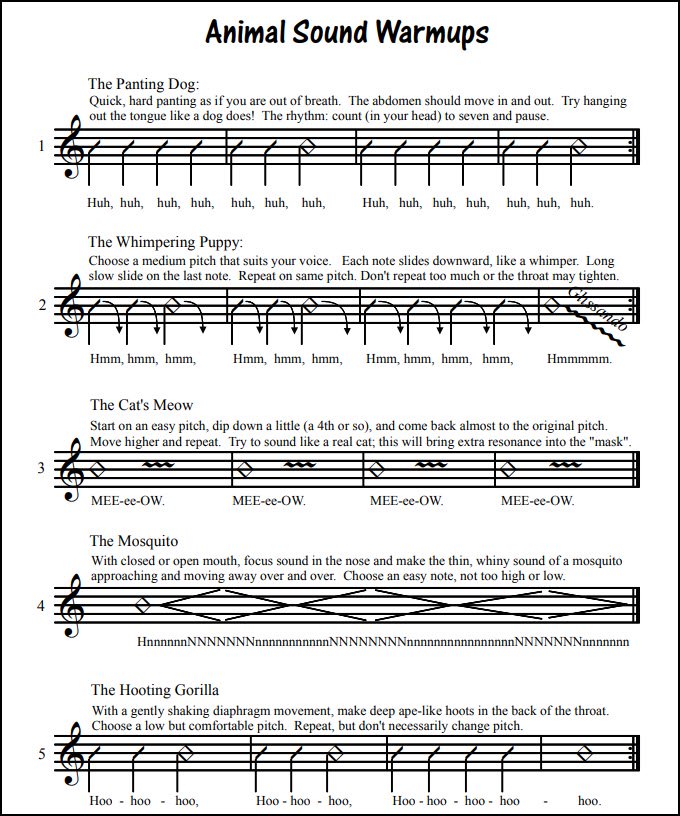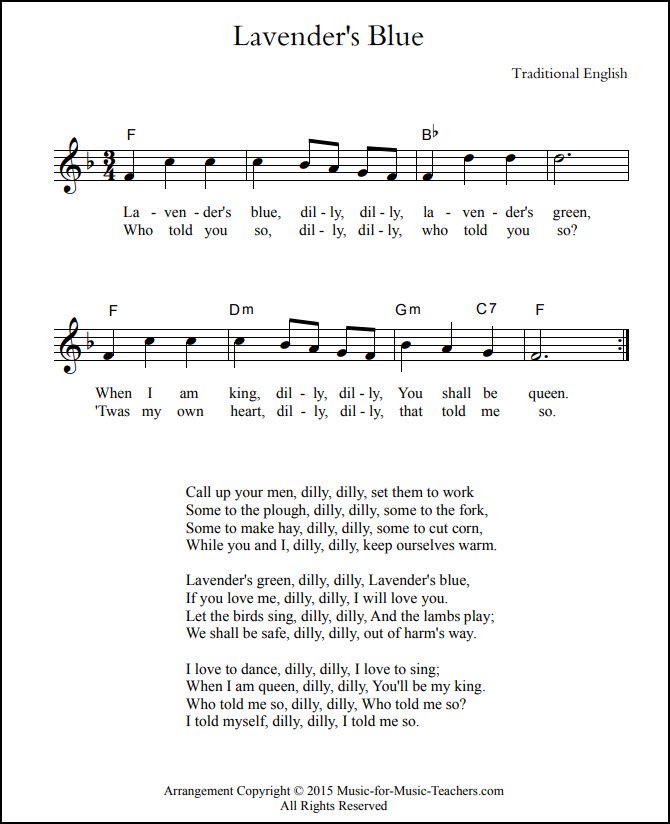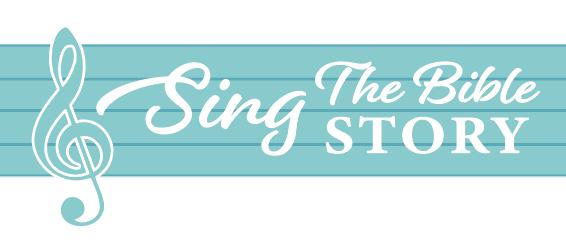How to Teach Voice Lessons, for the Almost- Beginner Teacher
Now, if you are TRULY a beginner, you won't be asked to teach voice lessons.
You are either a solo singer already, or you have some experience singing in choirs. Hopefully, you also have some skill at the piano as well, because without that skill you will be handicapped.

A weekly lesson sheet, from the very start
All of my students take homework sheets home with them, even the first week.
With this sheet, students have a reference to help them remember, and I have a record on my computer of what we covered the week before, plus a photo taken with my cell phone of what the sheet looks like after I've made additions to it during the actual lesson!
I need the sheet too!
This is very necessary for me; with more than just a few students, and an interval of a week between lessons, I am absolutely prone to forget.
Too much too soon?
You may think that this sheet is very ambitious for a first lesson.
Actually, we may not get to the third or even the second song, or the round "Heigh Ho" this week. (In that case, I'll just cross those items off the lesson sheet.)
But I want to be sure there is enough variety in the lesson for a young child, and especially if I'm starting a teenager.
- The warm-ups,
- breathing exercises, and
- posture discussion and work
are necessary, but they will only be KIND OF FUN, compared to the excitement of starting new songs.
We aren't talking about college-level singers transferring to your studio after some years of lessons and being willing to focus on just one song for a bit; we're talking about new singers.
Initially, a lot of choices
I like to expose these young children to at least one new song every week for a few weeks, and then we will settle down and focus on just a couple of songs a lesson, once they have identified a few they like.
So...
- POSTURE & BREATHING
- EXERCISES / WARMUPS
- REPERTOIRE SONGS
- ROUNDS (or harmonized pieces such as duets)
But every week, much repetition
Nothing is instant.
With young children, I acquaint them gradually with the foundational techniques of ultimate importance, posture and breathing.
Every week for a very long time, I demonstrate "the marionette string which comes off the BACK of the head, pulling the spine up.
We may walk to the door and flatten our backs and heads against it... kids are always surprised to realize they are not standing tall like their favorite Hollywood actors!
Their posture will improve!
We sit at the piano bench, slumping first, "Like the letter C", and then sit tall like cowboys, lower backs slightly arched and knees a bit apart, still with the imaginary strings pulling up and out the head and chest.
A quick way to good standing posture
Perhaps the fastest way to achieve excellent posture is asking them to:
- stand up
- stretch arms high straight overhead
- drop the arms slowly to the side, while keeping chest elevated and head high
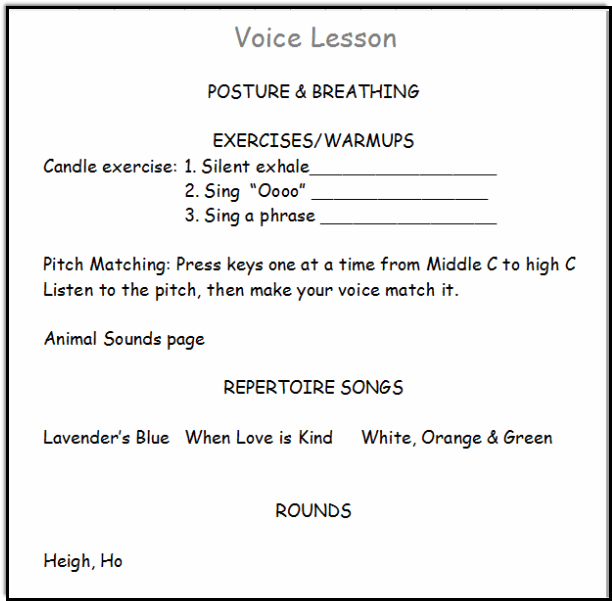
Breathing comes next
And now I'm going to sing the praises of Cheryl Porter's video course, "Free Your Voice!" (You can easily find it online - I'm not getting any commissions for promoting her wonderful courses.)
As much singing as I've done in my life, and despite my college-level singing classes, not one of my several teachers taught me correct breathing until she demonstrated laying on the floor, raising a book on your belly, then EXHALING WHILE KEEPING THE BOOK ELEVATED. (This is one of the exercises in "Lesson 3" of "Free Your Voice!," just one of her singing courses.)
For the next exercise, you stand up and exhale, STILL KEEPING YOUR BELLY EXPANDED. Why? To keep pressure off your throat.
If you allow your tummy to pull in as you sing, that pushes against your throat.
This is the "secret" I should have learned decades ago, but even belatedly, it has allowed me to move in and out of chest voice through my "break" with much greater ease and confidence, and make my voice stronger. It has changed EVERYTHING for me, and also for how I teach my students.
I encourage you to watch all you can of her free YouTube videos, and strongly consider buying her basic course (which is not so basic). Included are units on breathing, vibrato, changing from chest to middle to head voice register, and the greatly feared belting issue!
A side-note:
With my older, more experienced students (who also attend a choir class led by me, every two weeks), I am sharing many of Cheryl Porter's warm-up and vocalise exercises, and I am REQUIRING THEM TO LEARN to pick them out on the piano, warning them that I will be calling on them during choir to sit at the piano and play one of the assigned warm-ups, and THEY DON'T KNOW WHICH ONE.
Hahahahahahahahaha.
This approach has been quite effective at getting them to really learn and remember vocalises.
More on breathing
Look in the mirror and inhale without a lift of the shoulders. WATCH OUT for those shoulders! This is a very important habit for students to learn.

The candle exercise is effective
The candle exercise is a great favorite.
Hold up one finger, pretending it is a candle with a flame that you want to blow on carefully enough to make it waver, but not go out. That helps ensure a controlled diaphragm where the air is slowly released, not suddenly in a rush (keep the tummy expanded).
Watch the second hand on the studio clock... start together, and tell them to drop the "candle" when they run out of air. How many seconds? Write it down on the empty line. Next week, compare. Do this for several weeks.
The candle exercise is done 3 times:
- first, with silent blowing.
- Second, with an "oooo" all on one tone, in an easy part of the voice.
- Lastly, pick a song that the child knows - perhaps "Happy Birthday" or "Mary Had a Little Lamb," and begin singing it all on one breath with no new breaths or breaks (harder than it sounds - I do a bit of a drawing-out gesture with my free hand to encourage the voice to continue through the pauses in the song). All this time, I am blowing, "ooo-ing", and singing along with them. It is a competition, as well as modeling. Their posture needs to stay upright and beautiful all along.
- NO SHOULDERS!
What else is on this sheet? Let's see... here it is again:
Can they imitate a pitch?
Oh yes, pitch matching. This is something Cheryl Porter, vocal coach supreme, does in a child's first lesson. She sings a note or series of notes, then waits for the child to imitate her. (Again, you can find her on YouTube. She is an opera singer-turned-vocal coach. Best singing teacher I ever have had!)
I have had a few students who needed to work on "hearing" the piano key tones and hearing their own voice. But instead of using the piano, if they're having trouble matching pitch, SING the tone for them instead. It is easier to match a voice than to match a piano key.
Will they ever get better?
You may think a student with this lack of tone perception can't improve, but actually, I have seen GREAT IMPROVEMENT happen, especially when this exercise is employed faithfully together with a chosen repertoire piece being memorized and a recording listened to over and over again.
Is this a cure for tone deafness? I don't know, but I have seen amazing strides made, though not quickly.
Singers need a piano or keyboard at home
To do this tone-matching exercise at home, they must have a piano or a keyboard, of course. We do it together at my studio every week until I can see that they won't skip any of the black keys on their way from Middle C to higher C.
Oh, did I forget to mention that they should learn the names of piano keys?
If they don't know the piano already, then print a paper keyboard for them, and start quizzing them on the sheet each week. Don't fret that this will be boring for your young singers; they will think it's cool to know the names of the keys on the piano, if they don't know them already.
Animal Sounds warmups
Courage required!
The Animal Sounds page will give YOU a great opportunity to look and sound very silly... just the kind of encouragement they need to loosen up over the next few weeks and do the same.
Really! Yes, it may seem unbearably silly to them at first, but keep telling these shy ones that it takes much BRAVERY to be a singer.
I find that particular page of warm-ups very useful because:
- the puppy-dog pants encourage diaphragmatic breathing,
- the whimpering puppy, meowing cat, and mosquito sounds encourage RESONANCE and therefore effortless VOLUME, and
- the gorilla hoots encourage an open throat.
Lavender's Blue, a possible first song
What about Lavender's Blue? (This is a simple lead sheet, one of several in different keys to choose from on the Lavender's Blue page. There are piano arrangements as well, easy and also intermediate piano level.)
Sing a verse or two, then start over and invite them to sing along with you. Their voice will probably be very soft. This is only temporary, so don't worry. And don't make them worry about singing so softly. They'll get louder by and by.
In a few weeks, when they are more comfortable with you, start saying, "Louder. LOUDER. LOUDER!!" while demonstrating, or singing loudly with them. You can be sure that at home, in their bedrooms, they are singing louder than they are for you.
What about When Love is Kind, and White, Orange, and Green? These are all good beginner songs, though I have never given Lavender's Blue to a boy. For a boy, consider The Cat Came Back instead. Or The Erie Canal Song. (Girls also like these songs!)
And sing along with them, for now. It is much less intimidating for young kids to join in with you than to have to go solo! The louder they begin to sing, the more you can pull back your own volume.
What about the harmony of a round?
And the round Heigh Ho? For a first-lesson student???
Yes. It will be a long time before they are able to hold their part while I sing the other, but every week we will try it, and they will gradually improve. There is a lot to be learned from this "simple" song! How to measure out the breath, for one.
What about remembering when they get home?
Play it through a few times and direct them to a YouTube video, if their parents allow (write it on their lesson sheet).
But the recording app on your phone might be the best bet - on my iPhone it's called "Voice Memos" and makes pretty darn good recordings, which you can then share to their parents' phones in a text message.
If their parents don't play piano, this may be the best thing you can do to help them at home.
Let's examine a sheet for a NON-beginner
Just my ideas... I am not a voice specialist, but a piano teacher who has been shanghaied into teaching voice also!
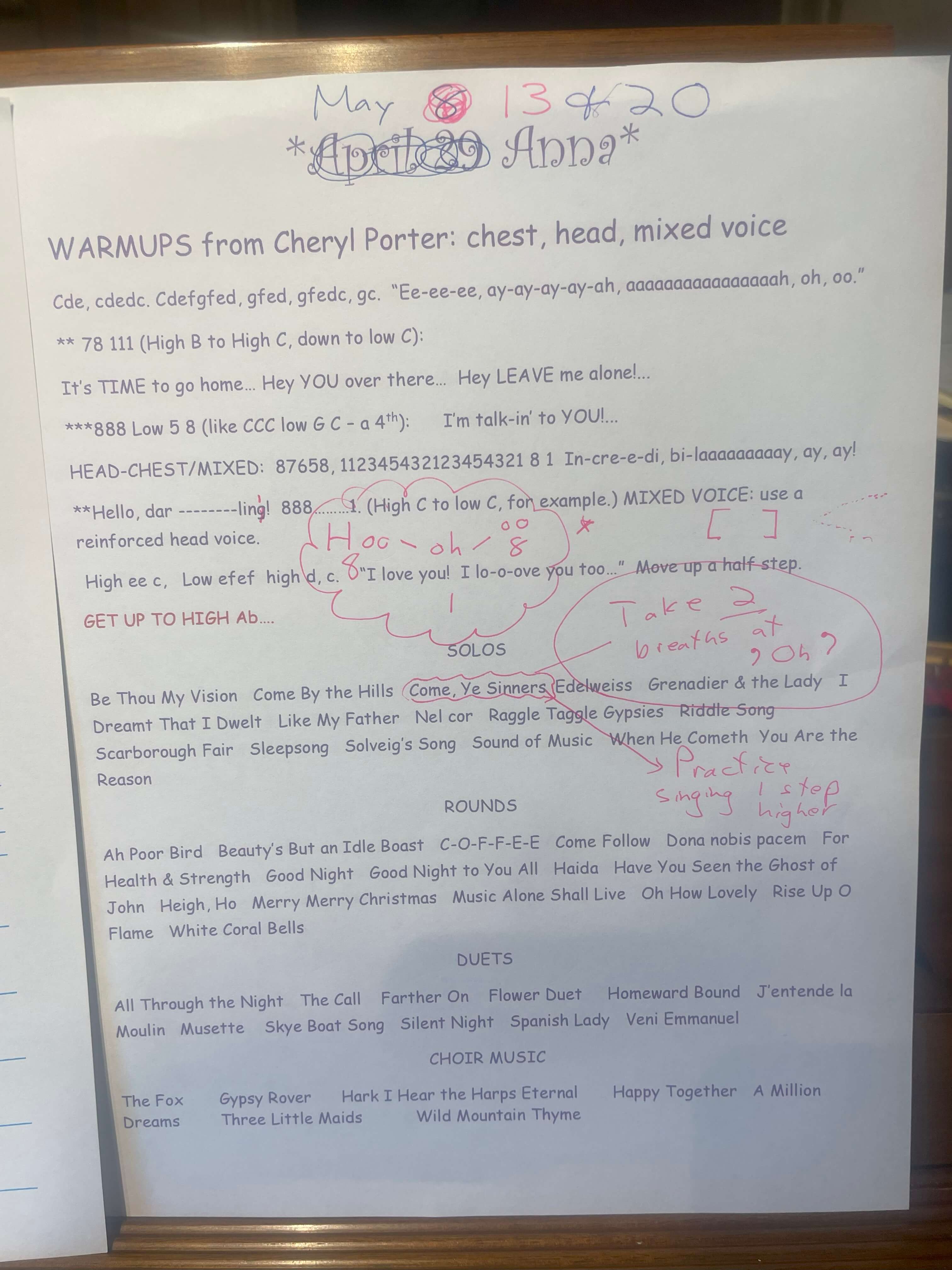
Anna has a lot of music on this page
But she has been taking lessons for a few years now.
Notice that the sheet has been used for at least 3 weeks - I'm a believer in saving ink!
A letter I received about teaching voice:
Hi,
I have recently been asked to teach vocal lessons for a six year old girl who has been taking vocal lessons for a while, but I haven’t had any formal training for this.
I have been taking choir for a number or years but I don’t know exactly how to teach music lessons, so I was wondering if you had any advice or pieces of music or books or something that I could use in my lesson that would teach her but still be fun.
Thanks, (Anonymous)
My Answer:
You need to start by focusing on POSTURE and BREATHING.
I do have quite a few ideas for teaching voice students, but you will have to read all through my site to garner these ideas! I suggest starting at the main vocal page, Free Vocal Sheet Music, which links to all the vocal music offered on my site.
Then look at the Broadway Musicals List page, which discusses my idea of suitable songs from musicals (they may differ from your ideas).
Then look at all the Singing warmups pages for more details about vocal production. Then, study all the folk songs pages on the site, because these are the most appropriate for a six year old.
At the bottom of my Broadway Musicals List page are some book suggestions for kids.
Share videos of other singers
Take a look at the Lavender's Blue sheet music - print it out for her, and show her the videos on that page.
Hearing her sing that song will give you a good idea of what she is capable of. Six years old is VERY YOUNG. I'm surprised she has already been taking lessons!
How much music should I cover a week?
In addition to Singing Warmups & Exercises, I like to cover about 3 songs per lesson, asking kids to memorize the lyrics of at least one verse every week.
Then, I usually have a ROUND that we work on together. "Heigh Ho, Nobody Home," "Have You Seen the Ghost of John," & "Ah, Poor Bird" are the easiest ones for beginners, and they can teach a great deal about breathing.
HOLDING THE PART may not come for a long time, but I just keep trying it again every week, because gradually they will get better.
My approach there is to sing it through together, then have them start over (while I play their part on the piano), then when they get to part 2, I start singing part 1, while continuing to play their part. Sometimes I am not so successful!
Can you accompany them?
Now, I'm making the assumption that you also play piano. If this is not the case, then teaching voice will be harder for you.
I have to admit I RARELY take students that young, especially voice students, because they can't read music. Everything must be recorded for them.
So ask her parents to send her with an iPhone or iPad or some other means of recording what you do - and have a lesson sheet made out that has dots or places to check off to show that she actually practices each day!
These are my suggestions.
Your choir background will stand you in good stead as you establish a routine for her lessons. I do spend time initially every lesson doing "sirens" & puppy dog whimpers (see the Animal Sounds Vocal Warm-Ups page) and other exercises that seem to make sense for the student's voice.
You may find you really enjoy singing with your own students - good luck! Spend time looking at other sites about teaching. You will find your way.
Dana
Dianna:
Your website is a light in the darkness. THANK YOU for all you do in helping to spread the love of music. It matters!
Recent Articles
-
Auld Lang Syne Sheet Music PDFs: for All Instruments & Singers!
Auld Lang Syne sheet music for New Year's Eve & other gatherings! Piano arrangements, guitar tabs, & lead sheets with chords in many keys, for all singers. -
Favorite Christmas Songs: Duet Vocal Sheet Music
The best duet Christmas songs are those ones you knew & loved as a child! This set of 14 "a capella" carols arranged for 2 voices is just right for caroling! -
"Walking In the Air" Piano Music from The Snowman
This sparkling piano arrangement of the main musical theme from The Snowman will win your students' hearts and imaginations, too, with its soaring beauty! -
Moonlight Sonata: How to Play Beethoven's Lovely Piece
Moonlight Sonata: How to play this beautiful but difficult piece full of black keys & triplets? With larger-than-usual notes, & letters inside the note heads! -
Classical Piano Sheet Music: a Set of Introductions
Classical piano sheet music - Fun, mostly one-page intros! Bach, Beethoven, Mozart & more - see what's new!
Interested in songs from the Bible for your students or church? Check out my other website, SingTheBibleStory.com!
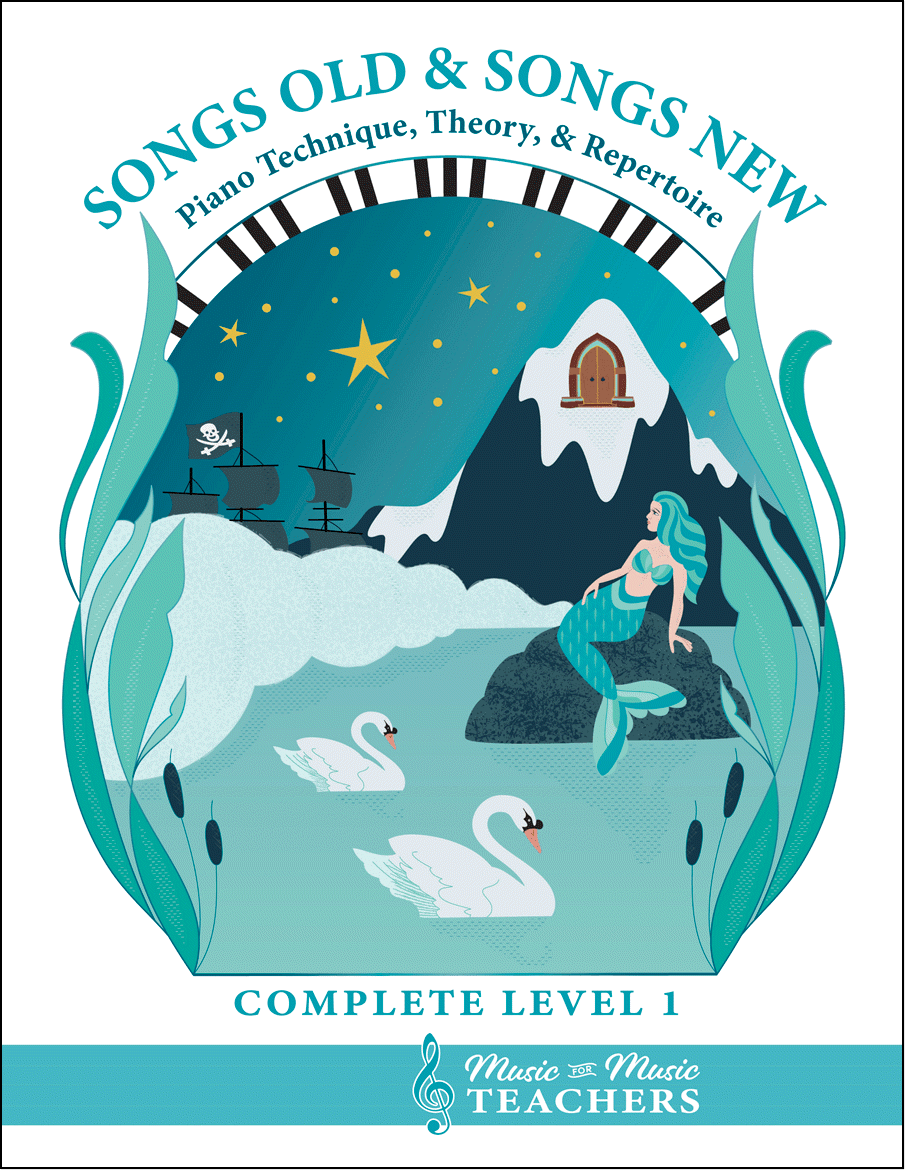
All the first-year material I give my beginner students.
Piano keyboard sheets, scales, chords, note-reading exercises, and over 256 pages of music!
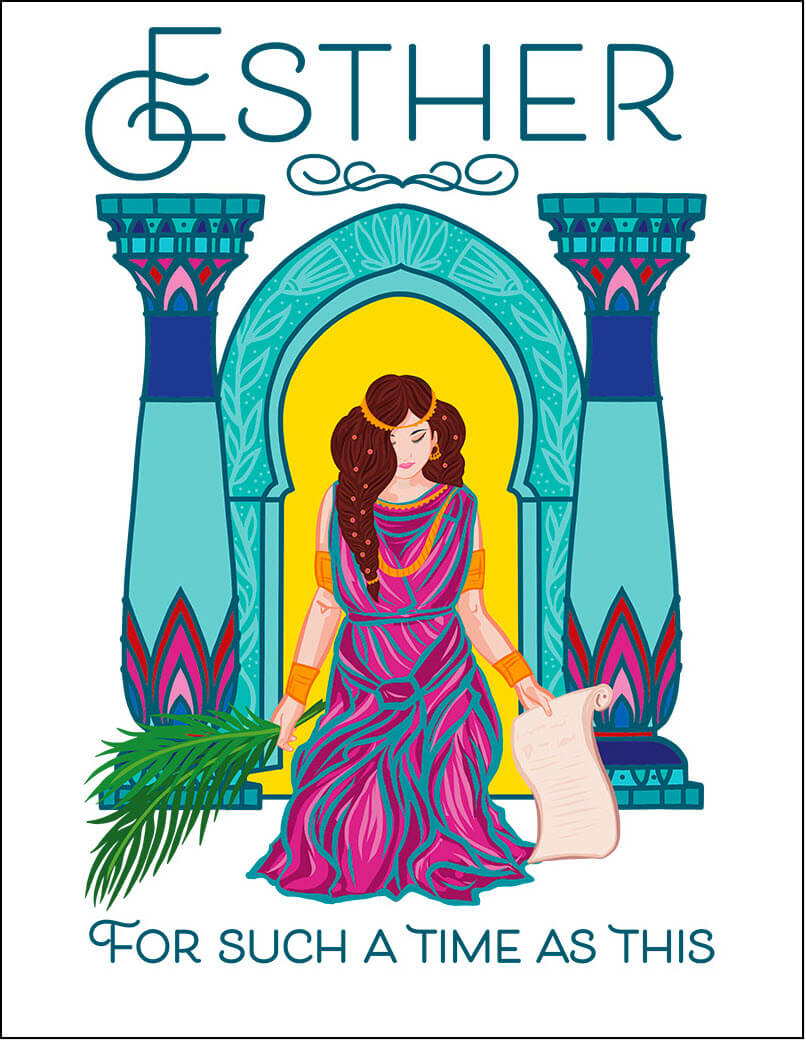
This beautiful song book for piano & voice "Esther, For Such a Time as This", available as a digital download, tells the riveting story of the time when Jews in ancient Persia faced a foe named Haman, and how a brave young queen risked her life to save her people.
A good choice for a singing story-teller, an operatic group, a short theater production, or a class of children!
This book is also available from Amazon as a paperback.
This book is available as a digital download from this site. Visit this page to see some free examples from the book.
It is also available from Amazon as a paperback!
This is the perfect easy start for little pianists.
And when they start reading white-key notes on the staff, this is a fun easy resource to say each week, "Choose a new black-key song at home this week and figure it out to show me next lesson!" They will be spending more time at the piano.
A perfect read aloud storybook
for little boys or girls.
The Adventures of Tonsta highlight the travels of a very young boy with a good heart, who goes about helping folk in trouble.
With a red cap on his head and a sack of tools slung over his shoulder, Tonsta seems to meet people in distress wherever he goes.
Lots of trolls in this book - including one who gives him a Christmas gift!
About the Author

Hi, I'm Dana! (Say that like "Anna".) I'm the owner of Music-for-Music-Teachers.com, and a newer site, SingTheBibleStory.com.
Like some of you, I've been playing the piano since early childhood, and have added a few other instruments along the way, plus an interest in arranging and composing music.
You can find out more about me and the reason for this website at my About Me page.
